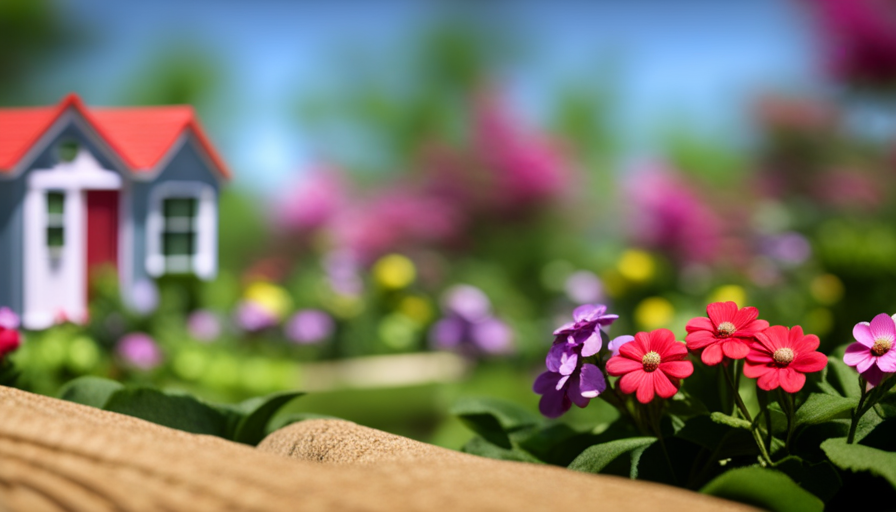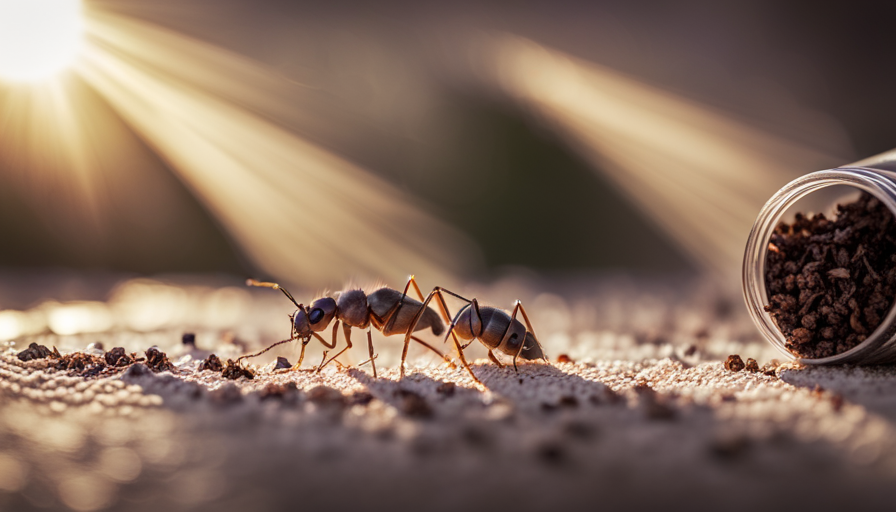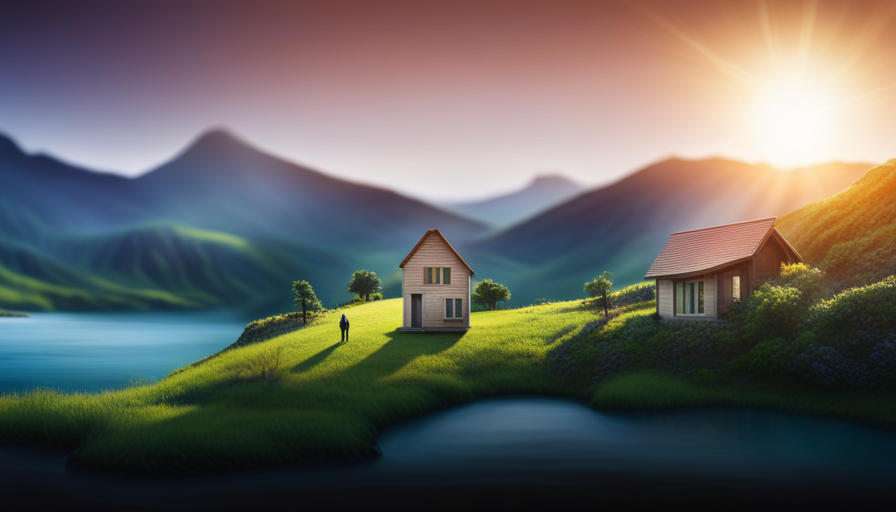The phrase, ‘Good things come in small packages,’ perfectly encapsulates the tiny house movement within the housing sector. These small living spaces have intrigued numerous individuals, providing an avenue for a simpler way of life and an opportunity to embrace sustainability. However, the question arises – what’s the current status of these tiny homes? How have they progressed from their initial inception?
In this article, we will delve into the world of tiny houses and explore their current status. From the evolution of their designs to the emergence of tiny house communities and villages, we will uncover the various ways in which these petite abodes have made their mark on the housing landscape. Additionally, we will examine the unique locations where tiny houses have found their footing, as well as the challenges and regulations that come with this unconventional way of living.
Join me as we delve into the world of tiny houses, weighing the pros and cons of this lifestyle and uncovering future trends and innovations. Get ready to be amazed by the ingenuity and creativity that lies within these small but mighty homes.
Key Takeaways
- Tiny houses offer a minimalist lifestyle and promote sustainability.
- Tiny house designs incorporate sustainable materials and off-grid living features.
- Tiny house communities promote sustainable living and togetherness.
- Zoning restrictions and building codes pose challenges for tiny house dwellers.
Evolution of Tiny House Designs
Now, let’s take a look at how tiny house designs have evolved over the years and how you can make your own tiny space feel even more spacious and functional.
Sustainable materials have become a key focus in modern tiny house designs. Builders are now using eco-friendly materials like reclaimed wood, bamboo, and recycled metal to construct these small homes. Not only do these materials reduce the environmental impact, but they also create a unique and stylish aesthetic.
Another trend in tiny house designs is the incorporation of off-grid living features. Many tiny homes now include solar panels, rainwater collection systems, and composting toilets, allowing homeowners to live completely off the grid. These features not only promote self-sufficiency but also reduce utility costs.
Transitioning into the subsequent section about tiny house communities and villages, it’s important to consider how these sustainable and off-grid features can be utilized on a larger scale.
Tiny House Communities and Villages
Explore the thriving communities and villages where you can find a cozy haven that fits your lifestyle like a glove. Tiny house communities and villages have become a popular choice for those seeking sustainable living and community building. These communities promote a sense of togetherness and cooperation, with residents sharing resources and supporting each other’s eco-friendly initiatives.
From the quaint streets of Portland to the picturesque landscapes of Colorado, there are numerous locations across the country that have embraced the tiny house movement. These communities often offer amenities such as communal gardens, shared workspaces, and social events, fostering a strong sense of belonging and connection.
Living in a tiny house village allows individuals to minimize their ecological footprint while enjoying a tight-knit community of like-minded individuals.
Transitioning now to unique locations for tiny houses, let’s explore how people are finding innovative ways to incorporate small dwellings into their dream destinations.
Unique Locations for Tiny Houses
Immerse yourself in the enchanting landscapes of unique locations for tiny houses, where you can wake up to the sound of crashing waves and fall asleep under a sky full of twinkling stars. Off grid living and unconventional architecture are the defining features of these extraordinary places. From secluded forest retreats to coastal havens, these locations offer a chance to disconnect from the chaos of modern life and reconnect with nature. Imagine living in a tiny house perched on a cliff, overlooking the vast expanse of the ocean. Or perhaps nestled in a remote mountain valley, surrounded by towering trees and breathtaking views. These unique locations provide an unparalleled opportunity to embrace a simpler way of life.
| Location | Highlights |
|---|---|
| Coastal Haven | Stunning ocean views, beach access |
| Forest Retreat | Serene surroundings, abundant wildlife |
| Mountain Valley | Majestic peaks, hiking trails |
As we explore the challenges and regulations of tiny house living, it becomes evident that these unique locations offer not only beauty and tranquility, but also a set of unique obstacles to overcome.
Challenges and Regulations
Living in these unique locations for tiny houses can be like navigating through a labyrinth, as individuals face challenges and regulations that can feel like trying to find a hidden treasure.
Zoning restrictions play a significant role in determining where tiny houses can be placed. Many cities and towns have specific rules that limit the use of tiny houses, such as minimum square footage requirements or restrictions on parking and utilities.
Additionally, building codes can pose challenges for tiny house dwellers. These codes often require specific safety features, such as minimum ceiling heights or fire safety measures, which can be difficult to incorporate into a tiny space.
However, despite these obstacles, the tiny house movement continues to grow, as people find creative solutions to navigate through the maze of regulations and make their dreams of tiny house living a reality.
This transition into the subsequent section about ‘tiny house living: pros and cons’ highlights the determination and resilience of those who choose this lifestyle.
Tiny House Living: Pros and Cons
Imagine the freedom of living in a space perfectly designed for you, with all the cozy comforts and minimalistic charm you crave. Tiny house living offers just that and more.
Here are some pros and cons to consider:
-
Sustainability: Tiny houses are often built with eco-friendly materials and use less energy and resources than traditional homes, making them a more sustainable housing option.
-
Financial freedom: With a smaller mortgage or no mortgage at all, tiny house owners can enjoy greater financial freedom and flexibility.
-
Minimalistic lifestyle: Living in a tiny house forces you to declutter and live with only what you truly need, promoting a simpler and more intentional way of life.
-
Customization: Tiny houses can be customized to fit your personal style and needs, allowing you to create a space that is uniquely yours.
-
Mobility: Many tiny houses are built on wheels, giving you the ability to easily move and explore different locations.
Looking towards the future, trends and innovations in tiny house design and technology continue to emerge, offering even more possibilities for sustainable and financially freeing living.
Future Trends and Innovations
In discussing the future trends and innovations in tiny house living, it’s important to consider the technological advancements in tiny house construction. These advancements have made it possible to build smaller and more efficient homes with innovative materials and techniques.
Additionally, the integration of smart home features into tiny houses has become increasingly popular. This allows homeowners to control various aspects of their living space with ease.
Lastly, as the tiny house movement continues to gain traction, we can expect to see an expansion of the movement. More people are embracing the idea of living in smaller, more sustainable homes.
Technological Advancements in Tiny House Construction
Don’t you just love how technology has made building and designing tiny houses so much easier and more efficient?
With the advent of 3D printing technology, constructing tiny houses has become a seamless process. 3D printed tiny houses are revolutionizing the industry by offering cost-effective and time-efficient solutions. These houses are constructed layer by layer, using sustainable building materials such as recycled plastics and environmentally friendly concrete alternatives.
Not only does this method reduce waste and lower construction costs, but it also allows for greater design flexibility and customization. Additionally, the integration of smart home features has further enhanced the functionality and convenience of tiny houses. By incorporating technologies like voice-activated assistants, automated climate control, and energy-efficient appliances, these homes have become more sustainable and comfortable.
Transitioning into the next section about the integration of smart home features, it’s fascinating to see how technology continues to shape the future of tiny house living.
Integration of Smart Home Features
As we’ve seen, technological advancements have revolutionized the construction of tiny houses, making them more efficient and sustainable. But it doesn’t stop there. The integration of smart home features takes tiny house living to a whole new level.
Smart home automation allows for convenient control of various aspects of the house, such as lighting, temperature, security, and entertainment systems, all from a single device. This not only enhances the comfort and convenience of living in a tiny house but also contributes to energy efficiency.
Smart thermostats, for example, can learn your preferences and adjust the temperature accordingly, optimizing energy usage. Additionally, smart lighting systems can be programmed to turn off automatically when not in use, saving electricity. With these advancements, tiny houses are becoming more sustainable and eco-friendly than ever before.
Now, let’s explore how the tiny house movement is expanding beyond its current boundaries.
Expansion of the Tiny House Movement
You might be surprised to discover just how far the tiny house movement has spread, with enthusiasts finding creative ways to embrace minimalist living in various unconventional spaces. The expansion of the tiny house movement has brought about a range of exciting developments, particularly in terms of sustainability and financing options.
-
Sustainable living: Tiny houses are inherently eco-friendly due to their small size, which reduces energy consumption and promotes a minimalist lifestyle. Many tiny house dwellers also incorporate sustainable features such as solar panels, rainwater harvesting systems, and composting toilets, further reducing their environmental impact.
-
Financing options: As the movement has gained popularity, financing options for tiny houses have become more accessible. Traditional mortgage lenders are now offering specialized loans for tiny homes, and there are even crowdfunding platforms specifically tailored for tiny house financing. Additionally, some cities have started to relax zoning and building regulations to accommodate tiny houses, making it easier for individuals to obtain permits and loans.
-
Community support: The expansion of the tiny house movement has also led to the formation of supportive communities. Tiny house enthusiasts often band together to share resources, knowledge, and experiences. These communities provide a valuable support network for individuals who are interested in or already living in tiny houses, creating a sense of belonging and camaraderie.
Overall, the expansion of the tiny house movement has brought about exciting advancements in sustainability and financing options, making it a viable and attractive housing alternative for many individuals.
Frequently Asked Questions
How much does it cost to build a tiny house?
Building a tiny house can have varying costs depending on factors such as size, materials, and location. A cost breakdown typically includes expenses for construction materials, permits, utilities, and labor. Financing options for building a tiny house may involve personal savings, loans, or crowdfunding.
It’s important to research and compare prices for materials and services to ensure cost-effectiveness. Additionally, exploring financing options and working with a budget can help make the process more manageable.
What are some popular design styles for tiny houses?
Minimalist interiors and creative storage solutions are popular design styles for tiny houses. Imagine a tiny house with a loft bed that doubles as a bookshelf and a dining table that folds down from the wall. These clever solutions maximize space while maintaining a clean and uncluttered aesthetic.
Minimalist interiors often feature neutral color palettes, sleek furniture, and cleverly placed windows to create an open and airy feel. These design choices allow for a harmonious and functional living space in a tiny home.
Are there any specific building codes or regulations for tiny houses?
Building code requirements and zoning regulations for tiny houses can vary depending on the location. It’s important to research and understand the specific regulations in your area before building a tiny house. Generally, building codes will cover aspects such as safety, structural integrity, and electrical systems.
Zoning regulations may dictate where tiny houses can be located, the size limitations, and whether they can be used as permanent residences. Compliance with these regulations is crucial to avoid legal issues and ensure a safe and functional living space.
What are the main challenges people face when living in a tiny house?
Main challenges faced when living in a tiny house are primarily due to space limitations. With limited square footage, every inch of the house must be utilized efficiently. Storage becomes a major concern, forcing individuals to adopt minimalistic lifestyles.
Additionally, privacy can be compromised, as there are limited separate spaces within the house. According to a survey conducted by The Tiny Life, 68% of tiny house dwellers reported that lack of space was the biggest challenge they faced.
Are there any unique or unconventional locations where people have built tiny houses?
Unusual locations and creative designs have become a popular trend for tiny house enthusiasts. People have built tiny houses in unique places such as treehouses, converted shipping containers, and even on floating platforms. These unconventional locations offer a sense of adventure and allow individuals to think outside the box when it comes to designing their tiny homes.
From repurposed vehicles to underground dwellings, the possibilities are endless for those seeking a truly one-of-a-kind living experience.
Conclusion
In conclusion, the tiny house movement has come a long way since its inception. The evolution of tiny house designs has led to more innovative and efficient living spaces.
With the rise of tiny house communities and villages, people are finding a sense of community and support in this alternative lifestyle. It’s interesting to note that, according to a recent survey, 68% of tiny house dwellers reported having lower monthly expenses compared to traditional homeowners.
However, challenges and regulations still exist, making it important for aspiring tiny house owners to consider their options carefully. Nevertheless, with future trends and innovations, the tiny house movement continues to inspire individuals to live simpler, more sustainable lives.
Hi, I’m Emma. I’m the Editor in Chief of Tiny House 43, a blog all about tiny houses. While tree houses are often associated with childhood, they can be the perfect adult retreat. They offer a cozy space to relax and unwind, surrounded by nature. And since they’re typically built on stilts or raised platforms, they offer stunning views that traditional homes simply can’t match. If you’re looking for a unique and romantic getaway, a tree house tiny house might just be the perfect option.










